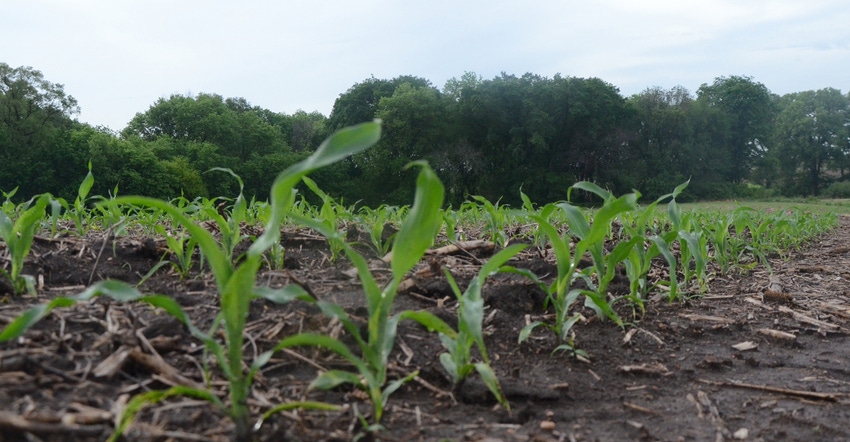
Growers in different parts of the Midwest dealt with dry conditions throughout the 2020 growing season. These dry conditions meant many growers were able to fall-apply anhydrous after an early harvest. However, for those applying in spring, it will be important to have a plan to protecting their nitrogen investment.
Tim Laatsch, director of agronomy in North America at Koch Agronomic Services, encourages the use of a nitrogen stabilizer as part of 2021 nitrogen management plans.
“One of the myths we often encounter is that spring applications are not subject to substantial loss and don’t need to be stabilized,” he says.
“We are seeing higher levels of spring precipitation,” he adds, citing research over the last 20 years by Jerry Hatfield at USDA’s National Soil Tilth Lab in Ames, Iowa. “Our research with universities and third parties over the last five years has repeatedly demonstrated economic response to stabilizing spring nitrogen applications.”
That said, choosing the right stabilizer can be challenging — it depends on the situation and agronomic practices used by the farming operation.
Stabilizer considerations
For those surface-applying or shallow-incorporating urea or liquid UAN, volatilization loss to the atmosphere is the biggest risk. With no-till and high residue fields, the risk is even greater. In these situations, a urease inhibitor is the best option for stabilization, Laatsch says. Urease inhibitors, like Koch’s Anvol, are designed to slow down urea hydrolysis and minimize losses to volatilization.
“Depending on the urease inhibitor, there are several different methods; they’re preventing urease from reacting with urea and causing it to gas off as NH3 gas,” explains Mick Goedeken, Central Valley Ag innovation agronomist. “When urease attacks the urea molecule, it steals from it, and it leaves as an NH3 gas. We want to prevent that anytime we’re surface-applying urea.”
On the other hand, for growers spring-applying anhydrous or preplant UAN, or those applying an early sidedress, belowground losses, like leaching and denitrification, are a bigger risk.
“When rainfall exceeds the average between April and June in that late-spring window, that’s when corn is not actively growing and absorbing nitrogen,” Laatsch says. “That’s when we are most susceptible to belowground losses.”
In these situations, nitrification inhibitors, like Koch’s Centuro, which slows the conversion of ammonium to nitrate in the soil, are the best option for protection.
“Nitrification inhibitors prevent ammonium from turning from NH4 to NO3,” Goedeken says. “The issue is, NH3 is the preferred form that gets taken up by the plant, but it’s also vulnerable to leaching. That’s the reason we want to keep it in ammonium form until the plant can use it.”
Enhanced-efficiency fertilizer (EEF) products like controlled-release and slow-release fertilizers are another option that provide a stabilized source of nitrogen or delay the availability of nitrogen after application, giving flexibility in timing and placement.
Goedeken explains that different controlled- and slow-release fertilizers use different polymers to coat urea to make nitrogen available in a specific amount of time. However, the right slow- or controlled-release product depends on the needs of the individual grower.
“You have to look at each system. It’s all part of a conversation about getting an understanding of when the grower wants the product applied,” Goedeken says. “We’re working now to create a blend of different polymer coatings to have some nitrogen available in 30 days, some in 60 days and some in 90 days.”
“I think about nitrogen stabilizers, urease and nitrification inhibitors as tools in your toolbox. Which tool you choose depends on the job you have to do,” Laatsch says. “You have to consider the source of nitrogen that works best in your operation and the risks associated with how and when you apply it, and match the tool to the risk profile that comes together from all those factors.”
Repercussions for 2021
Laatsch notes that the drought and downed corn in the 2020 season will have repercussions on 2021’s nitrogen management plans.
“We had yield reductions from downed corn and drought. That means we removed less nitrogen in corn grain than we applied as fertilizer, so we had lower agronomic efficiency,” Laatsch says. “That naturally leads to the question, what happened to all that nitrogen?”
Answering that question is complicated, Laatsch says. Considering how corn plants uptake nitrogen, and the events of the growing season. While the 2020 drought largely impacted corn at the reproductive growth stage, the straight-line winds knocked down corn after pollination.
“That tells us about 80% of total nitrogen needs may have already been taken into the plant at that point,” he says. “When less grain is made, or when we've got 30 to 50 bushels lying on the ground, the stalks, leaves and lost grain are going to hold a lot of nitrogen in organic form, likely until the next growing season. The release of that nitrogen can be very difficult to predict.”
With drier weather finishing out the 2020 season, Laatsch says it’s likely that less soil nitrogen was able to move into the plant late-season. However, the dry weather also limited leaching and denitrification risk. So, it’s also likely that more residual nitrogen was retained in the soil profile.
Goedeken notes the 2021 growing season will likely see a lot of nitrogen carried over. Growers who took fall soil nitrate tests can use that information to gauge where their soil nitrogen levels will be in spring, and adjust accordingly.
While it can be difficult to predict nitrogen mineralization in early spring, an option for the 2021 season is a pre-sidedress soil nitrate test (PSNT), which measures how much nitrogen is available in the soil at a time when the corn plant uses it.
“The PSNT test gives a good idea of where we are at that point, and what the nitrogen needs are for the remainder of the season,” Goedeken says. “It’s kind of like looking at the fuel gauge midseason.”
About the Author(s)
You May Also Like






